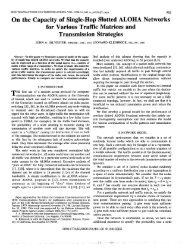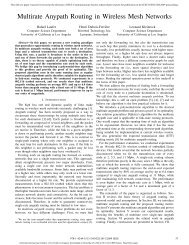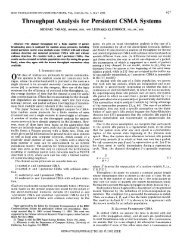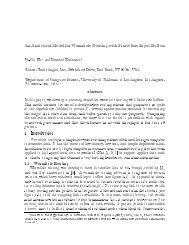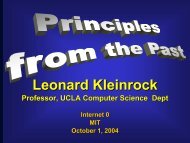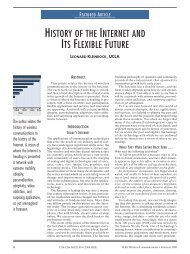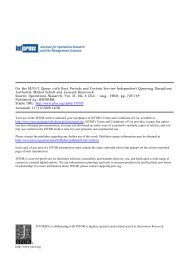Realizing the Wireless Internet - Leonard Kleinrock - UCLA
Realizing the Wireless Internet - Leonard Kleinrock - UCLA
Realizing the Wireless Internet - Leonard Kleinrock - UCLA
You also want an ePaper? Increase the reach of your titles
YUMPU automatically turns print PDFs into web optimized ePapers that Google loves.
<strong>Leonard</strong> <strong>Kleinrock</strong><br />
Professor, <strong>UCLA</strong> Computer Science Dept<br />
©<strong>Leonard</strong> <strong>Kleinrock</strong> 2007<br />
Keynote Lecture<br />
WCNC<br />
Hong Kong<br />
March 13, 2007
Outline<br />
1. Introduction<br />
2. A Brief History of <strong>the</strong> <strong>Internet</strong><br />
3. A Brief History of <strong>Wireless</strong><br />
4. The Early <strong>Internet</strong> Vision<br />
5. The Future Vision<br />
6. My Five Golden Guidelines for Research<br />
©<strong>Leonard</strong> <strong>Kleinrock</strong> 2007
©<strong>Leonard</strong> <strong>Kleinrock</strong> 2007<br />
1. Introduction
“What is <strong>the</strong> <strong>Internet</strong>”<br />
• The fa<strong>the</strong>r of Larry Garwood, my ophthalmologist,<br />
asked him,<br />
“What is <strong>the</strong> <strong>Internet</strong>”<br />
• Larry answered:<br />
“It’s everything, past, present and future.”<br />
• And so his fa<strong>the</strong>r challenged him …<br />
“I I was in <strong>the</strong> Canadian navy in World War II.<br />
I commanded assault landing craft LCA 1375 !”!<br />
“Go and find it on your <strong>Internet</strong>.”<br />
©<strong>Leonard</strong> <strong>Kleinrock</strong> 2007
©<strong>Leonard</strong> <strong>Kleinrock</strong> 2007
©<strong>Leonard</strong> <strong>Kleinrock</strong> 2007
©<strong>Leonard</strong> <strong>Kleinrock</strong> 2007
©<strong>Leonard</strong> <strong>Kleinrock</strong> 2007
©<strong>Leonard</strong> <strong>Kleinrock</strong> 2007
What Makes <strong>the</strong> <strong>Internet</strong> Tick<br />
1. The People: Hundreds of millions of<br />
people make <strong>the</strong>ir work available to<br />
o<strong>the</strong>rs on <strong>the</strong> net.<br />
2. The Culture: There is tremendous<br />
power in <strong>the</strong> early <strong>Internet</strong>’s s culture of<br />
openness, sharing and trust.<br />
The <strong>Internet</strong><br />
Creates Communities !<br />
©<strong>Leonard</strong> <strong>Kleinrock</strong> 2007
The <strong>Internet</strong> Has Dramatically<br />
Changed Some Fundamentals<br />
It has:<br />
• Reduced <strong>the</strong> barrier of distance<br />
• Increased <strong>the</strong> reach of an individual<br />
• Increased <strong>the</strong> number of people you can<br />
interact with<br />
• Increased <strong>the</strong> speed of interaction<br />
• Increased anonymity<br />
• Reduced cost of communicating<br />
• Expanded <strong>the</strong> quantity of accessible info.<br />
©<strong>Leonard</strong> <strong>Kleinrock</strong> 2007
©<strong>Leonard</strong> <strong>Kleinrock</strong> 2007<br />
The <strong>Internet</strong> Has Removed<br />
Barriers for Interaction<br />
•Political<br />
•Economic<br />
•Social<br />
•Cultural<br />
•Racial<br />
•Physical handicaps<br />
•Physical appearance.<br />
“On <strong>the</strong> <strong>Internet</strong>, nobody<br />
knows you’re a dog.”
2. A Brief History of <strong>the</strong> <strong>Internet</strong><br />
©<strong>Leonard</strong> <strong>Kleinrock</strong> 2007
Let’s s Go Back to <strong>the</strong> Beginning<br />
1969 Was an Incredible Year!<br />
1969<br />
•The first man landed on <strong>the</strong> moon<br />
•The Woodstock Festival took place<br />
•The Mets won <strong>the</strong> World Series<br />
•Charles Manson went on a killing spree<br />
•The <strong>Internet</strong> was born<br />
and nobody noticed!!<br />
©<strong>Leonard</strong> <strong>Kleinrock</strong> 2007
Before <strong>the</strong> Beginning!<br />
• 1957 Sputnik launched<br />
• 1958 ARPA formed as a response<br />
• 1959-62<br />
Len <strong>Kleinrock</strong> creates a ma<strong>the</strong>matical<br />
<strong>the</strong>ory of packet networks at MIT<br />
©<strong>Leonard</strong> <strong>Kleinrock</strong> 2007
Before <strong>the</strong> Beginning!<br />
• 1957 Sputnik launched<br />
• 1958 ARPA formed as a response<br />
• 1959-62<br />
Len <strong>Kleinrock</strong> creates a ma<strong>the</strong>matical<br />
<strong>the</strong>ory of packet networks at MIT<br />
• 1960-64<br />
64 Paul Baran at RAND proposes sending<br />
segmented messages in data networks<br />
• 1962 JCR Licklider 1 st Director of ARPA IPTO;<br />
galactic network vision of social<br />
interaction through networking of<br />
computers.<br />
and nobody cared!!<br />
©<strong>Leonard</strong> <strong>Kleinrock</strong> 2007
Before <strong>the</strong> Beginning!<br />
• 1965 Doug Englebart develops <strong>the</strong> mouse<br />
and concepts of hypertext<br />
• 1965 Larry Roberts/Tom Marill connect MIT<br />
Lincoln Labs with SDC over a dial-up line<br />
and publish paper on experiment in 1966<br />
• 1965 Donald Davies coins <strong>the</strong> word “packet”<br />
• 1966 Robert Taylor joins ARPA and brings<br />
Roberts <strong>the</strong>re to develop ARPANET<br />
• 1967 Davies creates 1-node 1<br />
NPL packet “net”<br />
• 1967 Wes Clark suggests use of a mini-<br />
computer as a network packet switch to<br />
unburden networking tasks from <strong>the</strong> host<br />
©<strong>Leonard</strong> <strong>Kleinrock</strong> 2007
The Arpanet Beginning<br />
• 1967 Many researchers supported by ARPA<br />
“So you want me to do research<br />
Buy me a Big computer…<br />
…with all <strong>the</strong> power everyone else has!”<br />
Researcher<br />
©<strong>Leonard</strong> <strong>Kleinrock</strong> 2007<br />
ARPA’s reply:<br />
“Here’s s an offer you<br />
can’t t refuse …..<br />
Join a Network, or<br />
lose your funding!<br />
ARPA
The Arpanet Beginning<br />
• 1967 ARPA ga<strong>the</strong>rs <strong>the</strong> “gang”<br />
• 1968 Roberts publishes ARPANET plan<br />
• 1968 RFP for a network goes out<br />
• 1968 BBN wins <strong>the</strong> contract under Frank Heart’s<br />
leadership & Bob Kahn’s s system design<br />
• 1968 <strong>Kleinrock</strong>’s lab at <strong>UCLA</strong> selected to be <strong>the</strong><br />
first node and serve as Network<br />
Measurement Center<br />
• 1969 (Jan-Aug) BBN & <strong>UCLA</strong> are Busy!<br />
• 1969 <strong>UCLA</strong> puts out Press Release<br />
©<strong>Leonard</strong> <strong>Kleinrock</strong> 2007
Ucla<br />
Press<br />
Release<br />
July 3, 1969<br />
“As of now, computer networks are Page still 2 in<br />
<strong>the</strong>ir infancy. But as <strong>the</strong>y grow up and<br />
become more sophisticated, we will probably<br />
see <strong>the</strong> spread of ‘computer utilities’ which,<br />
like present electric and telephone utilities,<br />
will service individual homes and offices<br />
across <strong>the</strong> country.”<br />
<strong>Leonard</strong> <strong>Kleinrock</strong><br />
©<strong>Leonard</strong> <strong>Kleinrock</strong> 2007
My 1969 vision …<br />
Ucla<br />
Press<br />
Release<br />
July 3, 1969<br />
“As of now, computer networks are Page still 2 in<br />
<strong>the</strong>ir infancy. But as <strong>the</strong>y grow up and<br />
become more sophisticated, we will probably<br />
see <strong>the</strong> spread of ‘computer utilities’ which,<br />
like present electric and telephone utilities,<br />
will service individual homes and offices<br />
across <strong>the</strong> country.”<br />
Web-based<br />
IP Services<br />
Always On<br />
Invisible<br />
Ubiquitous<br />
©<strong>Leonard</strong> <strong>Kleinrock</strong> 2007
The Arpanet Beginning<br />
• 1967 ARPA ga<strong>the</strong>rs <strong>the</strong> “gang”<br />
• 1968 Roberts publishes ARPANET plan<br />
• 1968 RFP for a network goes out<br />
• 1968 BBN wins <strong>the</strong> contract under Frank Heart’s<br />
leadership & Bob Kahn’s s system design<br />
• 1968 <strong>Kleinrock</strong>’s lab at <strong>UCLA</strong> selected to be <strong>the</strong><br />
first node and serve as Network<br />
Measurement Center<br />
• 1969 (Jan-Aug) BBN & <strong>UCLA</strong> are Busy!<br />
• 1969 <strong>UCLA</strong> puts out Press Release<br />
• 1969 8/29 BBN sends first switch (IMP) to <strong>UCLA</strong><br />
• 1969 9/2 First data moves from<br />
IMP<br />
<strong>UCLA</strong><br />
<strong>UCLA</strong> Host to <strong>UCLA</strong> switch<br />
©<strong>Leonard</strong> <strong>Kleinrock</strong> 2007
©<strong>Leonard</strong> <strong>Kleinrock</strong> 2007<br />
The 1969 IMP
©<strong>Leonard</strong> <strong>Kleinrock</strong> 2007<br />
The 1969 IMP
©<strong>Leonard</strong> <strong>Kleinrock</strong> 2007<br />
We Decided to Keep a Log
An Important Entry<br />
in Our IMP Log<br />
SRI<br />
<strong>UCLA</strong><br />
©<strong>Leonard</strong> <strong>Kleinrock</strong> 2007<br />
©<strong>Leonard</strong> <strong>Kleinrock</strong> 2006<br />
First Message on <strong>the</strong> <strong>Internet</strong><br />
- ever!
But What WAS <strong>the</strong> First Message<br />
Ever Sent on <strong>the</strong> <strong>Internet</strong><br />
• Was it “What hath God Wrought” (Morse 1844)<br />
(Morse 1844)<br />
• Or “Watson, come here. I want you.” (Bell 1876)<br />
• Or “One Giant Leap for Mankind” (Armstrong 1969)<br />
• It was simply a LOGIN from <strong>the</strong> <strong>UCLA</strong> computer<br />
to <strong>the</strong> SRI computer.<br />
SRI<br />
<strong>UCLA</strong><br />
• We sent an “L” - did you get <strong>the</strong> “L”<br />
©<strong>Leonard</strong> <strong>Kleinrock</strong> 2007<br />
YEP!<br />
• We sent an “O” - did you get <strong>the</strong> “O” YEP!<br />
• We sent a “G” - did you get <strong>the</strong> “G”
But What WAS <strong>the</strong> First Message<br />
Ever Sent on <strong>the</strong> <strong>Internet</strong><br />
• Was it “What hath God Wrought” (Morse 1844)<br />
(Morse 1844)<br />
• Or “Watson, come here. I want you.” (Bell 1876)<br />
• Or “One Giant Leap for Mankind” (Armstrong 1969)<br />
• It was simply a LOGIN from <strong>the</strong> <strong>UCLA</strong> computer<br />
to <strong>the</strong> SRI computer.<br />
• We sent an “L” - did you get <strong>the</strong> “L”<br />
YEP!<br />
• We sent an “O” - did you get <strong>the</strong> “O” YEP!<br />
• We sent a “G” - did you get <strong>the</strong> “G”<br />
©<strong>Leonard</strong> <strong>Kleinrock</strong> 2007
But What WAS <strong>the</strong> First Message<br />
Ever Sent on <strong>the</strong> <strong>Internet</strong><br />
• Was it “What hath God Wrought” (Morse 1844)<br />
(Morse 1844)<br />
• Or “Watson, come here. I want you.” (Bell 1876)<br />
• Or “One Giant Leap for Mankind” (Armstrong 1969)<br />
• It was simply a LOGIN from <strong>the</strong> <strong>UCLA</strong> computer<br />
to <strong>the</strong> SRI computer.<br />
• We sent an “L” - did you get <strong>the</strong> “L”<br />
YEP!<br />
• We sent an “O” - did you get <strong>the</strong> “O” YEP!<br />
• We sent a “G” - did you get <strong>the</strong> “G”<br />
©<strong>Leonard</strong> <strong>Kleinrock</strong> 2007
Growth of <strong>the</strong> <strong>Internet</strong><br />
• 1969 10/29 First <strong>Internet</strong> message<br />
• 1969 Howie Frank assists topology design<br />
• 1969 <strong>UCLA</strong>’s s Steve Crocker RFC #1<br />
Host-Host Protocol and <strong>the</strong> NWG<br />
• 1970 ARPANET spans US: <strong>UCLA</strong> < > BBN<br />
• 1970 <strong>UCLA</strong> team releases NCP<br />
• 1971 BBN TIP - direct terminal access<br />
• 1972 Ray Tomlinson introduces net email<br />
• 1972 First public demo of ARPANET<br />
©<strong>Leonard</strong> <strong>Kleinrock</strong> 2007
Enter <strong>the</strong> <strong>Wireless</strong> Networks<br />
• 1972 Norm Abramson’s s packet radio<br />
Alohanet connected to ARPANET<br />
• 1973 ARPA deploys SATNET<br />
-- 1st international connection<br />
• 1973 First analysis of slotted<br />
Aloha: performance, stability<br />
S = Ge -G<br />
©<strong>Leonard</strong> <strong>Kleinrock</strong> 2007<br />
<strong>Kleinrock</strong>, L. and S. Lam, "Packet Switching in a<br />
Slotted Satellite Channel", AFIPS Conference<br />
Proceedings, Vol. 42, National Computer<br />
Conference, New York, June 1973, AFIPS Press,<br />
Montvale, New Jersey, pp. 703-710, 1973
Enter <strong>the</strong> <strong>Wireless</strong> Networks<br />
• 1972 Norm Abramson’s s packet radio<br />
Alohanet connected to ARPANET<br />
• 1973 ARPA deploys SATNET<br />
– 1st international connection<br />
• 1973 First analysis of slotted<br />
Aloha: performance, stability<br />
• 1974 First analysis of CSMA<br />
S =<br />
Ge -aG<br />
G(1+2a) + e -aG<br />
<strong>Kleinrock</strong>, L. and F. Tobagi, "Carrier Sense Multiple<br />
Access for Packet Switched Radio Channels",<br />
Conference Record, International Conference on<br />
Communications, Minneapolis, Minnesota, pp. 21B-1<br />
to 21B-7, June 1974.<br />
©<strong>Leonard</strong> <strong>Kleinrock</strong> 2007
3. A Brief History of <strong>Wireless</strong><br />
©<strong>Leonard</strong> <strong>Kleinrock</strong> 2007
Who Made These Predictions<br />
• “It will be possible for a business man in New York to<br />
dictate instructions, and have <strong>the</strong>m instantly appear in<br />
type at his office in London or elsewhere.<br />
• “He will be able to call up, from his desk, and talk to any<br />
telephone subscriber on <strong>the</strong> globe.<br />
• “An inexpensive instrument, not bigger than a watch,<br />
will enable its bearer to:<br />
• hear anywhere,<br />
• on sea or land,<br />
• music or song,<br />
• <strong>the</strong> speech of a political leader,<br />
• <strong>the</strong> address of an eminent man of science,<br />
• or <strong>the</strong> sermon of an eloquent clergyman,<br />
• delivered in some o<strong>the</strong>r place, however distant.<br />
• “In <strong>the</strong> same manner any picture, character, drawing, or<br />
print can be transferred from one to ano<strong>the</strong>r place.<br />
• “The wireless art offers greater possibilities than any<br />
invention or discovery heretofore made, and … we can<br />
expect with certitude that in <strong>the</strong> next few years wonders<br />
will be wrought by its application."<br />
©<strong>Leonard</strong> <strong>Kleinrock</strong> 2007<br />
Nikola Tesla<br />
In 1908
The Giants of <strong>Wireless</strong><br />
Communication<br />
• James Clerk Maxwell<br />
• Heinrich Hertz<br />
“Ma<strong>the</strong>maticians<br />
…<br />
will even be doubtful<br />
whe<strong>the</strong>r <strong>the</strong> ideas as<br />
expressed in<br />
symbols had ever<br />
quite found <strong>the</strong>ir way<br />
out of <strong>the</strong> equations<br />
into <strong>the</strong>ir minds.”<br />
"I do not think that <strong>the</strong> wireless<br />
waves I have discovered will<br />
have any practical application."<br />
• Nikola Tesla<br />
• Guglielmo Marconi<br />
“Today’s s scientists have substituted<br />
ma<strong>the</strong>matics for experiments, and <strong>the</strong>y<br />
wander off through equation after equation,<br />
and eventually build a structure which has<br />
no relation to reality.”<br />
“Have I done <strong>the</strong> world good,<br />
or have I added a menace”<br />
©<strong>Leonard</strong> <strong>Kleinrock</strong> 2007
©<strong>Leonard</strong> <strong>Kleinrock</strong> 2007<br />
Radio Timeline<br />
• 1864: Maxwell ma<strong>the</strong>matically predicts <strong>the</strong><br />
existence of radio waves.<br />
• 1878: David E. Hughes sends/receives Morse<br />
Code, discovering radio waves.<br />
• 1885/6: Hertz proves existence of radio waves<br />
using a primitive transmitter and receiver.<br />
• 1891: Tesla is granted U.S. Patent revealing <strong>the</strong><br />
basic techniques for greatly improving<br />
radio transmitter performance.<br />
• 1893: Tesla demonstrates "wireless telegraphy"<br />
• 1894: Alexander Popov builds his first radio<br />
receiver in Russia, <strong>the</strong> first non-<br />
laboratory radio service.<br />
• 1894: Oliver Lodge transmits radio<br />
signals at Oxford University<br />
– One year after Tesla<br />
– One year before Marconi
©<strong>Leonard</strong> <strong>Kleinrock</strong> 2007<br />
Radio Timeline<br />
• 1895: Marconi transmits wireless signals a<br />
distance of about 1 mile<br />
• 1896: Tesla transmits wireless signals over<br />
distances of up to 30 miles.<br />
• 1897: Marconi is granted a British patent,<br />
establishes <strong>the</strong> world's first radio station<br />
and what later becomes <strong>the</strong> Marconi<br />
<strong>Wireless</strong> Telegraph Company<br />
• 1898: Popov effects ship-to<br />
to-shore<br />
communication over a distance of 6 miles<br />
• 1901: Marconi receives <strong>the</strong> first trans-Atlantic<br />
radio signal.<br />
• 1906: Lee de Forest invents <strong>the</strong> Audion, , now<br />
known as <strong>the</strong> vacuum-tube triode.<br />
• 1909: Marconi wins <strong>the</strong> Nobel Prize in physics<br />
• 1933: Edwin Armstrong patents FM
Radio<br />
Newfoundland<br />
©<strong>Leonard</strong> <strong>Kleinrock</strong> 2007
©<strong>Leonard</strong> <strong>Kleinrock</strong> 2007<br />
Radio
Packet<br />
• 1970’s: ARPA<br />
Radio<br />
250 cu in<br />
25 watts<br />
25 lbs<br />
©<strong>Leonard</strong> <strong>Kleinrock</strong> 2007
Packet<br />
Radio<br />
• 1970’s >> 1990’s: ARPA<br />
250 >>10 cu in<br />
25 >> 1 watt<br />
25 >> 1 lb<br />
©<strong>Leonard</strong> <strong>Kleinrock</strong> 2007
• 1970’s >> 1990’s: ARPA<br />
3G<br />
PCS<br />
GPRS<br />
EVDO<br />
TD-SCDMA<br />
3GPP<br />
3GPP2<br />
HSDPA<br />
WiFi<br />
WiMax<br />
Mesh nets<br />
Sensor nets<br />
IP Services<br />
Packet<br />
Radio<br />
250 >>10 cu in<br />
25 >> 1 watt<br />
25 >> 1 lb<br />
©<strong>Leonard</strong> <strong>Kleinrock</strong> 2007
©<strong>Leonard</strong> <strong>Kleinrock</strong> 2007
©<strong>Leonard</strong> <strong>Kleinrock</strong> 2007
Giant Stepping<br />
in Packet Radio<br />
• Multihop<br />
• Each hop covers distance R (Tx(<br />
Radius)<br />
• Total distance to cover is D (D>>R)<br />
• Delay per hop = T(R)<br />
• Big R, more interference, fewer hops<br />
• Small R, less interference, more hops<br />
• Total Delay = T(R)[D/R<br />
D/R]<br />
• Choose R=R * to minimize total delay<br />
• dT(R)/dR = T(R)/R optimality condition<br />
Reference: <strong>Kleinrock</strong>, L. "On Giant Stepping in Packet Radio Networks,"<br />
<strong>UCLA</strong>, Packet Radio Temporary Note #5, PRT 136 , March 1975.<br />
©<strong>Leonard</strong> <strong>Kleinrock</strong> 2007
dT(R)/dR = T/R<br />
T(R)<br />
Optimum Radius<br />
©<strong>Leonard</strong> <strong>Kleinrock</strong> 2007<br />
R *<br />
R
• 1973 ARPA deploys SATNET<br />
– 1st international connection<br />
• 1973 Cerf and Kahn design TCP<br />
• 1973 Bob Metcalfe develops E<strong>the</strong>rnet idea<br />
• 1975 ARPANET mgt transfers to DCA<br />
• 1978 TCP splits into TCP and IP driven by<br />
Danny Cohen (since 1973) , David Reed<br />
and John Schoch to support real-time<br />
traffic. This allows <strong>the</strong> creation of UDP.<br />
• 1980 CSNET funded by NSF in response to a<br />
proposal by Larry Landweber, , Dave<br />
Farber, Tony Hearn and Peter Denning<br />
• 1981 IBM introduces <strong>the</strong>ir first PC<br />
©<strong>Leonard</strong> <strong>Kleinrock</strong> 2007<br />
Growth of <strong>the</strong> <strong>Internet</strong>
©<strong>Leonard</strong> <strong>Kleinrock</strong> 2007<br />
Growth of <strong>the</strong> <strong>Internet</strong><br />
Dave Mills writes <strong>the</strong> initial software. Steve<br />
• 1983 ARPANET standardizes on TCP/IP<br />
• 1983 DCA splits MILNET from ARPANET<br />
• 1984 DNS introduced:<br />
Paul Mockapetris and Jon Postel<br />
• 1986 NSFNET at 56 Kbps for supercomputers;<br />
Wolff in charge.<br />
• 1988 NSFNET upgraded to T-1 T 1 backbone<br />
• 1988 Robert Morris unleashes 1 <strong>Internet</strong> worm<br />
• 1989 <strong>UCLA</strong> celebrates 20 anniversary<br />
• 1990 ARPANET replaced by NSFNET<br />
• 1991 Tim Berners-Lee<br />
Lee’s s WWW made available<br />
on <strong>the</strong> <strong>Internet</strong>
Growth of <strong>the</strong> <strong>Internet</strong><br />
• 1991 NSF opens <strong>Internet</strong> to commercial use<br />
• 1992 <strong>Internet</strong> Society formed<br />
• 1992 NSFNET upgraded to T-3 T 3 backbone<br />
• 1993 Marc Andreeson Mosaic browser<br />
• 1994 Cantor & Siegel introduce spam<br />
• 1994 BBN celebrates 25 anniversary<br />
• 1995 dot.com boom starts with faith that a<br />
“new economy” is beginning<br />
• 1996 Telecom Act deregulates data networks<br />
• 1996 More email than postal mail in USA<br />
• 1997 <strong>Internet</strong>2 consortium is established<br />
• 1997 IEEE releases 802.11 (WiFi) standard<br />
©<strong>Leonard</strong> <strong>Kleinrock</strong> 2007
Spam !<br />
• It surfaced as a critical and widely publicized<br />
event in April 1994 when two Arizona-based<br />
attorneys arguably became <strong>the</strong> two most<br />
hated individuals in <strong>the</strong> history of <strong>the</strong><br />
<strong>Internet</strong>. It was Lawrence Canter and Martha<br />
Siegel, <strong>the</strong> famous "green card lawyers" who<br />
"spammed" <strong>the</strong> <strong>Internet</strong>.<br />
©<strong>Leonard</strong> <strong>Kleinrock</strong> 2007
• From: Laurence Canter (nike@indirect.com(<br />
nike@indirect.com)<br />
Subject: Green Card Lottery- Final One<br />
Newsgroups: alt.bro<strong>the</strong>r-jed<br />
jed, alt.pub.coffeehouse.amethyst<br />
View: Complete Thread (4 articles) | Original Format<br />
Date: 1994-04<br />
04-12 00:40:42 PST<br />
Green Card Lottery 1994 May Be The Last One!<br />
THE DEADLINE HAS BEEN ANNOUNCED.<br />
The Green Card Lottery is a completely legal program giving away a<br />
certain annual allotment of Green Cards to persons born in certain<br />
countries. The lottery program was scheduled to continue on a<br />
permanent basis. However, recently, Senator Alan J Simpson<br />
introduced a bill into <strong>the</strong> U. S. Congress which could end any future<br />
lotteries. THE 1994 LOTTERY IS SCHEDULED TO TAKE PLACE<br />
SOON, BUT IT MAY BE THE VERY LAST ONE.<br />
PERSONS BORN IN MOST COUNTRIES QUALIFY, MANY FOR<br />
FIRST TIME.<br />
The only countries NOT qualifying are: Mexico; India; P.R. China;<br />
Taiwan, Philippines, North Korea, Canada, United Kingdom (except<br />
Nor<strong>the</strong>rn Ireland), Jamaica, Domican Republic, El Salvador and<br />
Vietnam.<br />
Lottery registration will take place soon. 55,000 Green Cards will be<br />
given to those who register correctly. NO JOB IS REQUIRED.<br />
THERE IS A STRICT JUNE DEADLINE. THE TIME TO START IS<br />
NOW!!<br />
For FREE information via Email, send request to<br />
cslaw@indirect.com<br />
The First<br />
Spam email<br />
*****************************************************************<br />
Canter & Siegel, Immigration Attorneys<br />
3333 E Camelback Road, Ste 250, Phoenix AZ 85018 USA<br />
cslaw@indirect.com telephone (602)661-3911<br />
Fax (602) 451-7617<br />
©<strong>Leonard</strong> <strong>Kleinrock</strong> 2007
• 1997 Leiner, , et al publish “The Past and Future<br />
History of <strong>the</strong> <strong>Internet</strong><br />
• 1998 Blogs begin to appear<br />
• 1998 VOIP equipment begins rolling out<br />
• 1999 <strong>UCLA</strong> celebrates 30 anniversary<br />
• 1999 Napster rolls out<br />
• 2000 dot.com bubble begins to burst<br />
• 2001 Napster forced to suspend service<br />
• 2003 Flash mobs gain popularity<br />
• 2003 World Summit on <strong>the</strong> Information Society<br />
(WSIS) 1 meeting in Geneva<br />
• 2004 <strong>UCLA</strong> celebrates 35 anniversary<br />
©<strong>Leonard</strong> <strong>Kleinrock</strong> 2007<br />
Growth of <strong>the</strong> <strong>Internet</strong><br />
<strong>Internet</strong>”http://www.isoc.org/internet/history/brief.shtm
Growth of <strong>the</strong> <strong>Internet</strong><br />
• 2004 USA phone Revenue:<br />
mobile = fixed line = $50 billion<br />
• 2004 USA leads in avg minutes for a cell call<br />
USA =15-20, Korea = 8, Japan = 6, Britain = 5, World = 3<br />
• 2004 Camera-enabled enabled phone sales exceed<br />
combined sales of digital + film camera<br />
• 2005 812 million cell phones sold<br />
219 million laptops sold<br />
• 2005 Google is <strong>the</strong> darling of <strong>the</strong> <strong>Internet</strong><br />
• 2005 Peer-to<br />
to-Peer Grows; Supreme Court<br />
Decision supports RIAA et al.<br />
• 2005 Grokster closes down<br />
©<strong>Leonard</strong> <strong>Kleinrock</strong> 2007
Growth of <strong>the</strong> <strong>Internet</strong><br />
• 2005 AT&T disappears<br />
• In 1983 it was <strong>the</strong> world’s s largest corporation with<br />
assets > $125 billion<br />
• On November 18, it ceased to exist as an<br />
independent company; SBC bought AT&T<br />
• It employed some of <strong>the</strong> world’s s best scientists<br />
and worst managers and died of stupidity.<br />
• 2005 AT&T reappears<br />
• SBC renames itself as AT&T<br />
• 2005 Google maps and Google Earth<br />
appear<br />
• 2005 Web 2.0 technologies (e.g., social<br />
networks, blogs, wikis) ) heat up<br />
©<strong>Leonard</strong> <strong>Kleinrock</strong> 2007
Growth of <strong>the</strong> <strong>Internet</strong><br />
• 2005 MySpace has more page views than<br />
Google<br />
• 2006 Is Google evil<br />
• 2006 YouTube purchased by Google<br />
for $1.65 billion<br />
• 2006 Nanotechnology showing up<br />
• 2007 AT&T largest US Carrier again!<br />
• 2007 2007 Mobile TV, ads, apps and<br />
content<br />
©<strong>Leonard</strong> <strong>Kleinrock</strong> 2007
The Personalities Who Brought<br />
Us All This Technology<br />
©<strong>Leonard</strong> <strong>Kleinrock</strong> 2007
Some of <strong>the</strong> <strong>Wireless</strong> Personalities<br />
The Early Pioneers<br />
©<strong>Leonard</strong> <strong>Kleinrock</strong> 2007
Some of <strong>the</strong> <strong>Internet</strong> Personalities<br />
The Early Pioneers<br />
The<br />
Implementers<br />
The Value<br />
Adders<br />
The Launchers<br />
The Billionaires<br />
©<strong>Leonard</strong> <strong>Kleinrock</strong> 2007
4. The Early <strong>Internet</strong> Vision<br />
©<strong>Leonard</strong> <strong>Kleinrock</strong> 2007
Did you see<br />
this coming<br />
Remember Well …<br />
my Yes 1969 and Vision No !<br />
The Press<br />
Me<br />
©<strong>Leonard</strong> <strong>Kleinrock</strong> 2007
So What Was<br />
My Early <strong>Internet</strong> Vision<br />
• The <strong>Internet</strong> technology will be everywhere<br />
• Always accessible<br />
• Always on<br />
• Anyone can plug in any device anywhere<br />
• Invisible<br />
©<strong>Leonard</strong> <strong>Kleinrock</strong> 2007
The <strong>Internet</strong> Almost<br />
Got it Right<br />
Yep<br />
Yep<br />
Yep<br />
ope<br />
Nope<br />
The <strong>Internet</strong> technology will be everywhere<br />
Always accessible<br />
Always on<br />
Anyone can plug in any device anywhere<br />
Invisible<br />
©<strong>Leonard</strong> <strong>Kleinrock</strong> 2007
What Did <strong>the</strong> <strong>Internet</strong> Get Wrong<br />
• The <strong>Internet</strong> model grew up assuming that<br />
• <strong>the</strong> end user,<br />
• his device,<br />
• its IP address,<br />
• his location<br />
• are always tightly coupled.<br />
This is no longer true:<br />
<strong>the</strong> nomads are taking over<br />
Joe’s computer<br />
Joe’s computer’s IP Address<br />
Joe<br />
©<strong>Leonard</strong> <strong>Kleinrock</strong> 2007<br />
Joe’s Office
Enablers<br />
for <strong>the</strong> Dark Side<br />
• The <strong>Internet</strong> allows anyone to reach<br />
hundreds of millions of users<br />
easily,<br />
quickly,<br />
at essentially no cost (in money or effort),<br />
anonymously.<br />
• This is a perfect formula for enabling <strong>the</strong><br />
dark side of <strong>the</strong> <strong>Internet</strong>.<br />
©<strong>Leonard</strong> <strong>Kleinrock</strong> 2007
5. The Future Vision<br />
The Edge Evolves<br />
©<strong>Leonard</strong> <strong>Kleinrock</strong> 2007
Extending My <strong>Internet</strong> Vision:<br />
The <strong>Internet</strong>’s s Next Five Phases<br />
Phase 1: Nomadic Computing<br />
Phase 2: Embedded Technology (or<br />
Smart Spaces/Smart Nets)<br />
Phase 3: Ubiquitous Computing<br />
Phase 4: Convergence<br />
Phase 5: Software Agents<br />
©<strong>Leonard</strong> <strong>Kleinrock</strong> 2007
Phase 1: Nomadic Computing<br />
In Your Office You Have ...<br />
• A High performance workstation<br />
• Access to high speed networks<br />
• Support from an IT Systems Administrator<br />
You lose <strong>the</strong> last 2 as soon as you<br />
go on <strong>the</strong> road !<br />
We need a portable network<br />
administrator.<br />
©<strong>Leonard</strong> <strong>Kleinrock</strong> 2007
The Future Vision<br />
Phase 1: Nomadic Computing<br />
In Your Office You Have ...<br />
The system support to provide<br />
• A High performance workstation<br />
<strong>the</strong> nomadic user with trouble-<br />
free <strong>Internet</strong> service from<br />
• Access to high speed networks<br />
any device,<br />
any place,<br />
• Support from an IT Systems Administrator<br />
at any time.<br />
©<strong>Leonard</strong> <strong>Kleinrock</strong> 2007
Phase 2: Embeded Technology:<br />
Smart Spaces & Smart Networks<br />
• Our environment will be<br />
alive with technology all<br />
around us<br />
• In <strong>the</strong> walls<br />
• In my desk<br />
• In my belt<br />
• In my eyeglasses<br />
• In my refrigerator<br />
• In my automobile<br />
• In my fingernails<br />
• In my hotel room.<br />
• Thousands of<br />
processors per<br />
human<br />
• Logic, memory<br />
• Communications<br />
• Actuators, sensors<br />
• Cameras,<br />
• Microphones,<br />
speakers<br />
• Displays.<br />
©<strong>Leonard</strong> <strong>Kleinrock</strong> 2007
Phase 2: Embeded<br />
• Our environment will be<br />
alive with technology all<br />
around us<br />
• In <strong>the</strong> walls<br />
• In my desk<br />
• In my belt<br />
• In my eyeglasses<br />
• In my refrigerator<br />
• In my automobile<br />
• In my fingernails<br />
• In my hotel room.<br />
©<strong>Leonard</strong> <strong>Kleinrock</strong> 2007<br />
The Future Vision<br />
Embeded Technology:<br />
Smart Spaces & Smart Nets<br />
• Thousands of<br />
processors per<br />
human<br />
Small intelligent devices<br />
embedded in <strong>the</strong> physical world<br />
and connected to <strong>the</strong> <strong>Internet</strong><br />
• Logic, memory<br />
• Communications<br />
• Actuators, sensors<br />
• Cameras,<br />
• Microphones,<br />
speakers<br />
• Displays.
©<strong>Leonard</strong> <strong>Kleinrock</strong> 2007<br />
What WILL be Connected
©<strong>Leonard</strong> <strong>Kleinrock</strong> 2007<br />
What WILL be Connected
The Future Vision<br />
Phase 3: Ubiquitous Computing<br />
• Sequence of ubiquitous access<br />
technologies:<br />
• Dial-up access<br />
• Copper DSL<br />
• Cable modems<br />
• Satellite access<br />
• Cellular 3G, 4G etc<br />
• WiFi<br />
• WiMax<br />
• Fiber.<br />
©<strong>Leonard</strong> <strong>Kleinrock</strong> 2007
Computing Goes Un-te<strong>the</strong>red<br />
• WiFi spreading<br />
• Cellular pervasive<br />
• Ultra Wide Band showing on product<br />
roadmaps<br />
• Cognitive Radio emerging in Standards<br />
• RFID use in inventory management<br />
• IEEE Zigbee moving forward in pervasive low-<br />
cost sensor networks<br />
• Near Field Communication finding its way into<br />
almost touch transaction-based computing<br />
©<strong>Leonard</strong> <strong>Kleinrock</strong> 2007
The Future Vision<br />
Phase 3: Ubiquitous Computing<br />
<strong>Internet</strong> service availability<br />
wherever <strong>the</strong> nomad travels on<br />
a global basis<br />
©<strong>Leonard</strong> <strong>Kleinrock</strong> 2007
The Future Vision<br />
Convergence<br />
Phase 4: Convergence<br />
Content<br />
Function<br />
Services<br />
©<strong>Leonard</strong> <strong>Kleinrock</strong> 2007
Let’s s Focus on <strong>the</strong> Mobile Device<br />
©<strong>Leonard</strong> <strong>Kleinrock</strong> 2007
It is a Content Rendering Device<br />
©<strong>Leonard</strong> <strong>Kleinrock</strong> 2007
On The Road<br />
• A person who carries a digital watch,<br />
a 2-way 2<br />
email pager, cell phone, MP3<br />
player, PDA, camera, GPS and notebook<br />
computer is carrying:<br />
• 8 displays,<br />
• 6 keyboards,<br />
• 5 speakers,<br />
• 3 microphones,<br />
• 8 clocks,<br />
• 8 batteries and 7 chargers<br />
• 4 communication devices.<br />
©<strong>Leonard</strong> <strong>Kleinrock</strong> 2007<br />
This is Ridiculous!
Let’s All s Converge This Garbage Them I Into Carry One Around<br />
Device<br />
Camera<br />
Portable<br />
MP3/Video<br />
GPS Device<br />
Pager<br />
Television<br />
Phone<br />
Rolodex<br />
Camcorder<br />
FM Radio<br />
PDA<br />
Game Console<br />
©<strong>Leonard</strong> <strong>Kleinrock</strong> 2007<br />
Walkie-Talkie<br />
watch<br />
PC
©<strong>Leonard</strong> <strong>Kleinrock</strong> 2007<br />
The Converged Smart Phone<br />
Features<br />
• Phone<br />
• Messaging<br />
• Calendar<br />
• E-mail<br />
• <strong>Internet</strong><br />
Access<br />
• Camera<br />
• Music Player<br />
• Game Player<br />
• <strong>Wireless</strong><br />
Headset<br />
Future Enhancements<br />
• Touchscreen<br />
• Large, high resolution screen<br />
• Powerful processor<br />
• Vast storage space<br />
• Considerable battery life<br />
• Intuitive input system<br />
• Video Phone<br />
• Movie Player<br />
• Mobile TV<br />
• GPS Mapping<br />
• Compass<br />
• Accelerometer<br />
• Wi-Fi Connectivity<br />
• Software defined radio<br />
• Pocket-size
The Device Earlier Known as<br />
<strong>the</strong> Cell Phone<br />
Will Become a Communicating<br />
Multifunction Rendering Device<br />
©<strong>Leonard</strong> <strong>Kleinrock</strong> 2007
A Converged Phone<br />
Those keyboards<br />
are getting smaller<br />
But My Fingers<br />
Are Not !<br />
©<strong>Leonard</strong> <strong>Kleinrock</strong> 2007
The Screens Are Getting Smaller<br />
And My Eyes<br />
Are Getting<br />
Weaker<br />
©<strong>Leonard</strong> <strong>Kleinrock</strong> 2007
How Far Have We Come in 35<br />
Honeywell DDP-516<br />
Interface Message Processor<br />
1969<br />
circa<br />
Years<br />
PalmOne Treo<br />
circa 2004<br />
Connected to <strong>Internet</strong> via<br />
Connected to <strong>Internet</strong> via<br />
©<strong>Leonard</strong> <strong>Kleinrock</strong> 2007<br />
50 kbps leased line<br />
50 kbps GPRS link<br />
Ref: Henry Samueli, Broadcom, Inc.
What is <strong>the</strong> Mobile Device<br />
• Traditional View<br />
It’s s a Phone<br />
• Hollywood View<br />
It’s s a Tiny TV<br />
• Silicon Valley View<br />
It’s s a PDA<br />
• Game Industry View<br />
It’s s a GameBoy<br />
• Correct View<br />
It’s s a Whole New Medium !<br />
©<strong>Leonard</strong> <strong>Kleinrock</strong> 2007
The Fourth Screen is Here<br />
and Always With You<br />
Phone Screen<br />
PC Screen<br />
Movie Screen<br />
TV Screen<br />
©<strong>Leonard</strong> <strong>Kleinrock</strong> 2007
New Services<br />
Multi-Billion Dollar Industries<br />
• Ring-back tones (fan tones)<br />
• Music Streaming<br />
• Full Song Downloads<br />
• Music Video Downloads<br />
• Full Video Downloads<br />
• Gaming<br />
• Gambling<br />
• Sports.<br />
©<strong>Leonard</strong> <strong>Kleinrock</strong> 2007
Motivated <strong>Wireless</strong> Ads<br />
Sign up customers (e.g., students)<br />
Offer <strong>the</strong>m cash for watching ads <strong>the</strong>y request<br />
15 second ads download to <strong>the</strong>ir cellphone at night<br />
Advertisers choose demographic and location<br />
Customer clicks on icon immediately after watching an ad:<br />
This generates <strong>the</strong> cash ($1 per ad)<br />
This satisfies advertiser that ad was viewed.<br />
©<strong>Leonard</strong> <strong>Kleinrock</strong> 2007<br />
http://www.blowfishworks.com/
<strong>Wireless</strong> Heart Implant<br />
• The Medtronic Chronicle monitors blood<br />
pressure and o<strong>the</strong>r conditions inside <strong>the</strong> hearts<br />
of patients suffering heart failure.<br />
• The goal is send a wireless alert to warn<br />
patients, <strong>the</strong>ir doctors and caregivers when <strong>the</strong>y<br />
are in danger at a point before <strong>the</strong>y need to be<br />
hospitalized.<br />
Friday, March 2, 2007 Medtronic's Chronicle Fails<br />
©<strong>Leonard</strong> <strong>Kleinrock</strong> 2007
<strong>Wireless</strong> Sensor for Diabetics<br />
• Peripheral neuropathy<br />
• Pressure sensor<br />
Pressure<br />
Alert<br />
Shoe<br />
©<strong>Leonard</strong> <strong>Kleinrock</strong> 2007<br />
Pressure<br />
Sensor<br />
<strong>Wireless</strong><br />
Processor<br />
MediNode<br />
Cellphone<br />
PDA, iPod<br />
MediSens <strong>Wireless</strong>, Inc.<br />
27621 San Valle, Mission Viejo, CA 92692
Valentine’s s Day: Feb 14, 2007<br />
• 50-mile backup on Pennsylvania’s s I-78I<br />
©<strong>Leonard</strong> <strong>Kleinrock</strong> 2007<br />
• Gov. Ed Rendell said <strong>the</strong> recent fiasco on<br />
Interstate 78 included a "total breakdown<br />
in communications."
Valentine’s s Day:<br />
It Could Have Been Better<br />
• With picture phones that now include<br />
GPS, drivers could have informed officials<br />
and <strong>the</strong>y could have pieced toge<strong>the</strong>r<br />
detailed mile-by mile photo maps --<br />
"mashed up" with Google maps of<br />
precisely where <strong>the</strong> worst conditions<br />
were!<br />
©<strong>Leonard</strong> <strong>Kleinrock</strong> 2007
©<strong>Leonard</strong> <strong>Kleinrock</strong> 2007<br />
Location-Based Services<br />
• The obvious location-based services - <strong>the</strong> ones<br />
available today - are<br />
• Basic mapping<br />
• Direction finding<br />
• Yellow Pages-style style listings<br />
• New location-based services:<br />
• Mashup services that let users create, tag, and annotate<br />
<strong>the</strong>ir own maps<br />
• Passive Service:<br />
• “This is a quality restaurant”<br />
• “This is City Hall”<br />
• Active Services:<br />
• Note left for spouse to buy milk here<br />
• “Family or friends are nearby”<br />
• “Interesting performance going on in this auditorium”<br />
• Ad from a store offering a discount now<br />
• Camera phone that can read bar codes<br />
• Cameras that can read coupons on your cellphone
From Convergence<br />
to Divergence<br />
©<strong>Leonard</strong> <strong>Kleinrock</strong> 2007
With Convergence Comes<br />
Divergence<br />
• Bluetooth earpiece<br />
• Implanted pacemaker<br />
• The advanced nerd<br />
• Head-mounted displays<br />
• Minority Report<br />
• Things you didn’t t anticipate<br />
©<strong>Leonard</strong> <strong>Kleinrock</strong> 2007
Yet More Divergence in <strong>the</strong><br />
Environment<br />
The Intelligent Car<br />
©<strong>Leonard</strong> <strong>Kleinrock</strong> 2007
The Future Vision<br />
Phase 5: 5 Software Agents<br />
• Intelligent software agents will be<br />
deployed across <strong>the</strong> network whose<br />
function it will be to<br />
• Mine data<br />
• Act on that data<br />
• Observe trends<br />
• Carry out tasks dynamically<br />
• Adapt to <strong>the</strong>ir environment.<br />
©<strong>Leonard</strong> <strong>Kleinrock</strong> 2007
©<strong>Leonard</strong> <strong>Kleinrock</strong> 2007<br />
So What’s s <strong>the</strong> Infrastructure<br />
Vision<br />
Start With Mine From 1969:<br />
• The <strong>Internet</strong> technology will be everywhere<br />
• Always accessible<br />
• Always on<br />
• Anyone can plug in any device anywhere<br />
• Invisible<br />
We Got That Far<br />
We Are On Our Way to <strong>the</strong> Next Steps:<br />
Now Let’s s Expand That Vision:
An Expanded Vision of <strong>the</strong> Future<br />
©<strong>Leonard</strong> <strong>Kleinrock</strong> 2007<br />
• Armies of Nomads dashing about<br />
• Small pervasive devices ubiquitously<br />
embedded in <strong>the</strong> physical world,<br />
• Providing <strong>the</strong> capabilities of<br />
• actuators, sensors, logic, memory, processing,<br />
communications, speakers, microphones, cameras,<br />
displays, etc.<br />
• Intelligent software agents deployed across<br />
<strong>the</strong> network<br />
• whose function it is to<br />
• mine data, act on that data, observe trends, carry out<br />
tasks dynamically and adapt to <strong>the</strong>ir environment.<br />
• Considerably more network traffic<br />
generated not so much by humans, , but by<br />
<strong>the</strong>se embedded devices and <strong>the</strong>se<br />
intelligent software agents.
An Expanded Vision of <strong>the</strong> Future<br />
• Large collections of self-organizing,<br />
independent yet cooperative adaptive<br />
systems that can operate in unpredictable<br />
environments<br />
• Vast, fast networks.<br />
• Huge amounts of information flashing<br />
across <strong>the</strong>se global networks<br />
instantaneously, with this information<br />
undergoing enormous processing and<br />
informing <strong>the</strong> sophisticated decision<br />
support and control systems of our<br />
society.<br />
©<strong>Leonard</strong> <strong>Kleinrock</strong> 2007<br />
(cont)<br />
The <strong>Internet</strong> will essentially be a<br />
pervasive global nervous system.
6. My Five Golden Guidelines for<br />
Research<br />
©<strong>Leonard</strong> <strong>Kleinrock</strong> 2007
My Five Golden Guidelines to<br />
Research<br />
1. Conduct <strong>the</strong> 100-year test.<br />
2. Don’t t fall in love with your model.<br />
3. Beware of mindless simulation.<br />
4. Understand your own results.<br />
5. Look for “Gee, that’s s funny!”<br />
©<strong>Leonard</strong> <strong>Kleinrock</strong> 2007
Richard Hamming<br />
"Why do so few scientists<br />
make significant contributions<br />
and so many are forgotten in<br />
<strong>the</strong> long run"<br />
“If you don't work on important<br />
problems, it's not likely that<br />
you'll do important work.”<br />
©<strong>Leonard</strong> <strong>Kleinrock</strong> 2007<br />
Richard W. Hamming, “You and Your Research”, March 7, 1986.
1. The 100 Year Test<br />
• Hamming once asked me,<br />
“What progress of today will be remembered<br />
1000 years from now ”<br />
Will your work be remembered 100 years<br />
from today<br />
©<strong>Leonard</strong> <strong>Kleinrock</strong> 2007
2. But Don’t t Fall in Love With<br />
Your Model<br />
The<br />
Ma<strong>the</strong>matical<br />
Model of<br />
The Real World<br />
Real<br />
Approximation<br />
World<br />
Solution to <strong>the</strong><br />
Ma<strong>the</strong>matical<br />
Model<br />
©<strong>Leonard</strong> <strong>Kleinrock</strong> 2007
Michael Faraday<br />
• "I could not imagine much progress by<br />
reading only, without experimental facts and<br />
trials … I was never able to make a fact my<br />
own without seeing it. “ (Faraday: 1827)<br />
• Faraday performed in his brain <strong>the</strong> work of a<br />
great ma<strong>the</strong>matician without using a single<br />
ma<strong>the</strong>matical formula” (Hermann von<br />
Helmholtz : April 5, 1881 )<br />
©<strong>Leonard</strong> <strong>Kleinrock</strong> 2007
3. Beware of Mindless Simulation<br />
Ask <strong>the</strong> Obvious Questions<br />
©<strong>Leonard</strong> <strong>Kleinrock</strong> 2007
4. Understand Your Own Results<br />
©<strong>Leonard</strong> <strong>Kleinrock</strong> 2007
Response Time<br />
Throughput<br />
Loss<br />
RESPONSE TIME<br />
T<br />
Input<br />
CAPACITY<br />
Throughput<br />
0<br />
LOSS<br />
©<strong>Leonard</strong> <strong>Kleinrock</strong> 2007<br />
Network Cloud
Response Time vs Throughput<br />
T( )<br />
Now let’s ask a good question:<br />
Do you want<br />
to operate<br />
here<br />
Or here<br />
Response<br />
Time<br />
©<strong>Leonard</strong> <strong>Kleinrock</strong> 2007<br />
0<br />
Throughput<br />
( )
Response 4. Understand Time Your vsOwn Throughput Results<br />
Let me define a new metric of performance:<br />
T( ) P =<br />
Response<br />
Time<br />
0<br />
1/P<br />
<strong>Kleinrock</strong>, L., "On Flow Control in Computer Networks", Conference Record,<br />
Proceedings ©<strong>Leonard</strong> <strong>Kleinrock</strong> of <strong>the</strong> International 2007 Conference on Communications, Vol. II,<br />
Toronto, Ontario, pp. 27.2.1 to 27.2.5, June 1978.<br />
Throughput<br />
POWER =<br />
Response Time<br />
T( )<br />
*<br />
The main<br />
result<br />
Power is<br />
max when<br />
dT( ( )/d = T( )/<br />
Throughput<br />
Max Power Point<br />
( )
Response 4. Understand Time Your vsOwn Throughput Results<br />
Let’s Dig Deeper on Understanding<br />
T( )<br />
For M/M/1<br />
this gives<br />
max Power at<br />
N * = 1<br />
Why <br />
Response<br />
Time<br />
Max Power Point<br />
0<br />
<strong>Kleinrock</strong>, L., "On Flow Control in Computer Networks", Conference Record,<br />
Proceedings ©<strong>Leonard</strong> <strong>Kleinrock</strong> of <strong>the</strong> International 2007 Conference on Communications, Vol. II,<br />
Toronto, Ontario, pp. 27.2.1 to 27.2.5, June 1978.<br />
*<br />
Throughput<br />
( )<br />
©<strong>Leonard</strong> <strong>Kleinrock</strong> 2006
4. Understand Your Own Results<br />
Use Your Intuition<br />
Only 1 customer<br />
in <strong>the</strong> system<br />
Insight:<br />
Just keep <strong>the</strong><br />
pipe full!<br />
©<strong>Leonard</strong> <strong>Kleinrock</strong> 2007<br />
T<br />
T = Min<br />
Eff = Max
4. Understand Your Own Results<br />
• Our intuition says put exactly one person<br />
in <strong>the</strong> queueing system<br />
• This was from “deterministic” reasoning.<br />
• We can’t t actually do that in general<br />
• BUT our earlier result said that we should<br />
adjust <strong>the</strong> system to achieve an average<br />
of one person in <strong>the</strong> queueing system, i.e.,<br />
At Max Power<br />
N * = 1<br />
for M/M/1<br />
Gee, that’s s funny!<br />
<strong>Kleinrock</strong>, L., "On Flow Control in Computer Networks", Conference Record,<br />
Proceedings ©<strong>Leonard</strong> <strong>Kleinrock</strong> of <strong>the</strong> International 2007 Conference on Communications, Vol. II,<br />
Toronto, Ontario, pp. 27.2.1 to 27.2.5, June 1978.<br />
©<strong>Leonard</strong> <strong>Kleinrock</strong> 2006
©<strong>Leonard</strong> <strong>Kleinrock</strong> 2007<br />
5. Gee, that’s s funny!
5. Gee, that’s funny!<br />
What can we say for M/G/1 <br />
M/G/1<br />
N*=1<br />
M/M/1<br />
T( )<br />
©<strong>Leonard</strong> <strong>Kleinrock</strong> 2007<br />
0
More on Modeling<br />
•Moving <strong>the</strong> frontier is tough<br />
(we mislead our students)<br />
•Once you do it, you will be able to repeat it<br />
(students don’t t believe us)<br />
•Teach your students to understand <strong>the</strong>ir<br />
results!<br />
•Generalization usually comes when you can<br />
see <strong>the</strong> simplicity of a solution<br />
•Keep your interest in related areas, areas<br />
where something might happen.<br />
©<strong>Leonard</strong> <strong>Kleinrock</strong> 2007
©<strong>Leonard</strong> <strong>Kleinrock</strong> 2007<br />
www.lk.cs.ucla.edu



